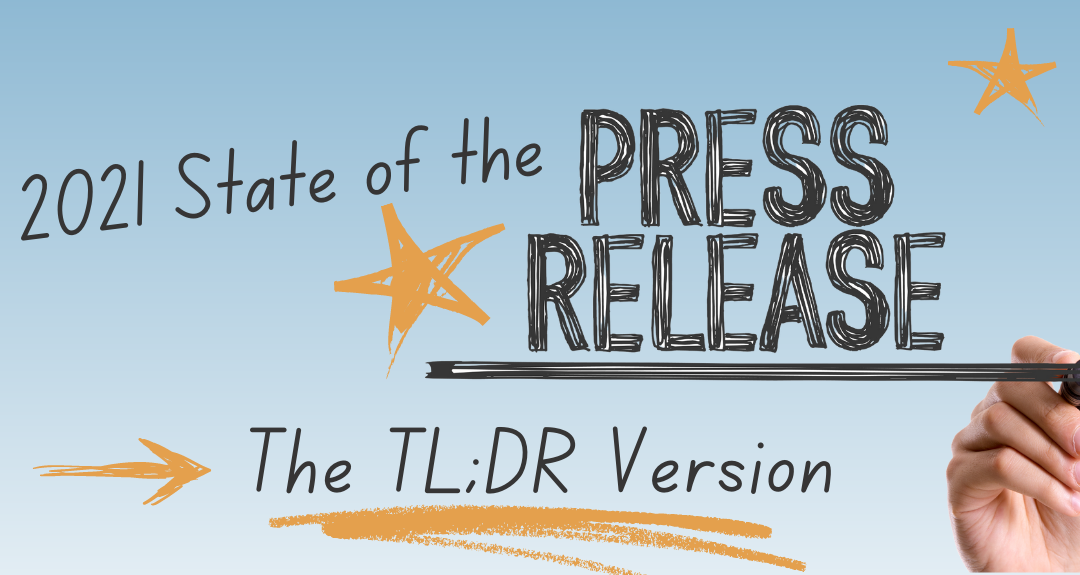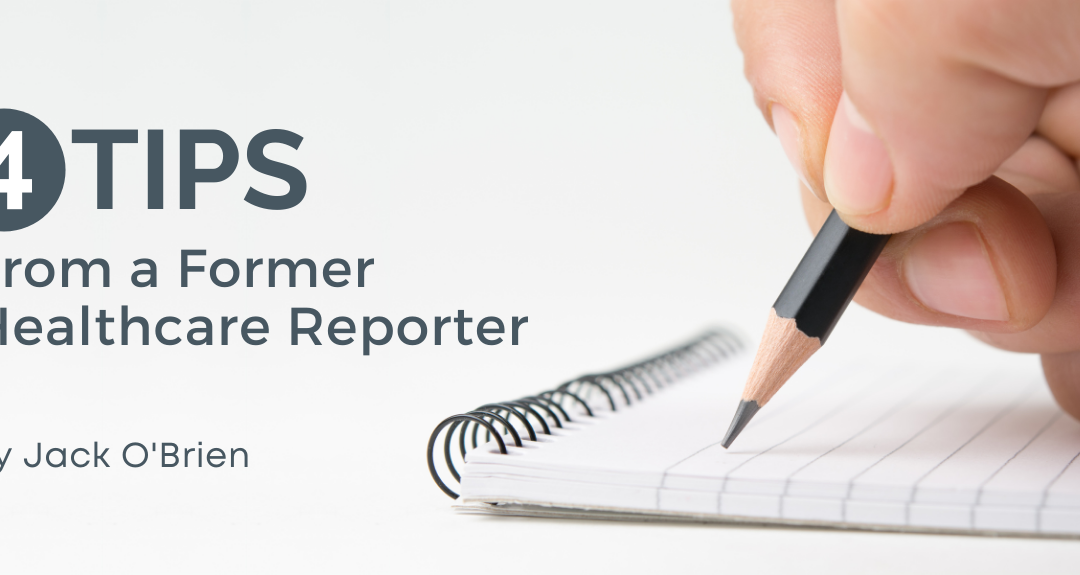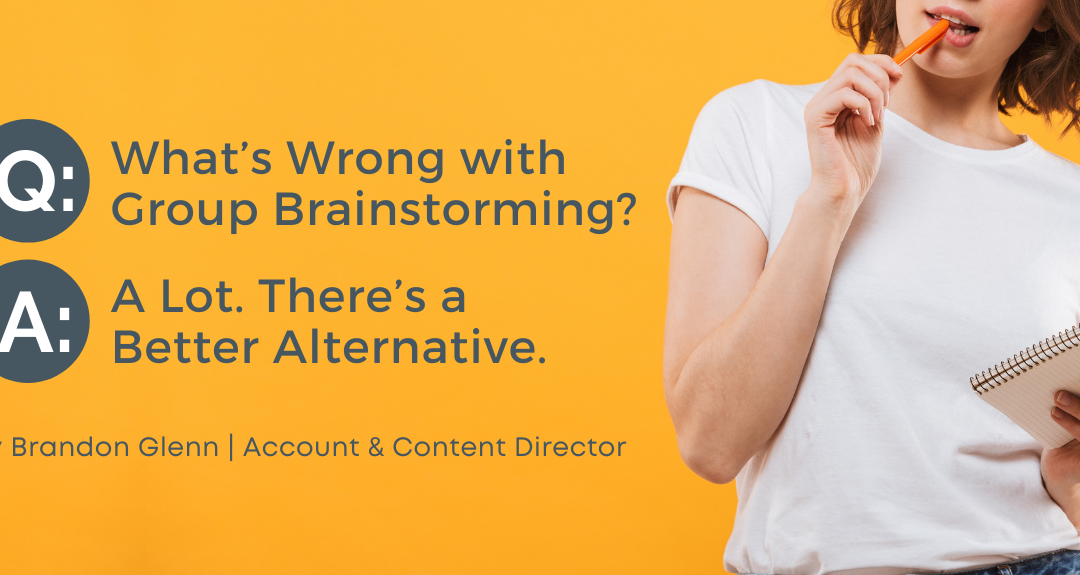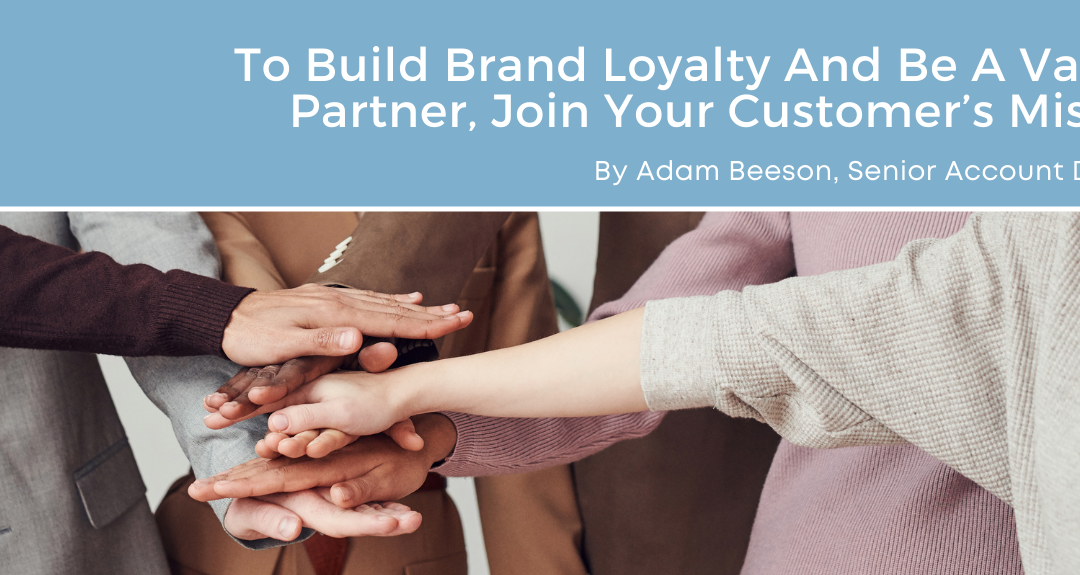
by Brandon Glenn | Nov 10, 2021 | Blog
There are a few yearly traditions Americans rally behind and await with eager longing and hushed anticipation – birthdays, holidays and the publishing of Cision’s “State of the Press Release” report.
The 2021 version of this annual 20-something-page paean to the press release – brought to you by the people who profit the most from press releases, it bears keeping in mind – recently arrived on our virtual doorstep. As is the hallowed tradition in these parts, we read the report and summarize it below to save you the anguish, remorse and indignity.
The report is the result of Cision’s examination of more than 100,000 press releases from the prior year, coupled with a survey of PR pros about their press release practices. For those of you who find the full report too long and do not want to read it (TL;DR), here are five key take-aways to consider:
- In terms of volume, the industry has returned to a pre-COVID-19 level of “normal”: Seventy-four percent of respondents said that their press outreach was either on par or more frequent than before COVID or not impacted by the pandemic at all.
- Thought leadership releases represent an opportunity for some companies (and a business development opportunity for Cision): As virtually anyone familiar with the concept of a press release knows, the primary reason (83%) companies distribute them is to share business news. Cision notes that just 47% of companies use press releases to share thought leadership content, such as research, data, tips and best practices. Other leading reasons for issuing press releases include: product launches (40%); diversity, equity and inclusion (25%); and corporate social responsibility (19%).
- For headlines, less is more: Certainly, headlines are critical to a release’s messaging, and Cision recommends keeping them fewer than 70 characters. Email applications and Google’s search engine will cut off any text over that amount, according to Cision.
- Mind your action verbs: The verb “announce” is popular in headlines but doesn’t generate a commensurate amount of page views. “Launch” is also widely used but performs proportionately better with its usage. Also consider “show,” “roll out,” “reveal,” and “allow.”
- Check it twice: Not surprisingly when dealing in the written word, Cision found thousands of errors in “final” releases sent by clients. The most common types of errors include: hyperlink errors, misspellings, incorrect dateline dates, grammar mistakes and day/date discrepancies.
What will 2022 hold in store for the state of the press release? The sheer possibilities almost exceed the human capacity for thought (or at least mine) but be sure to return here next year to learn all about it. Until then, our nation turns its lonely eyes to you, Cision.

by Jodi Amendola | Oct 27, 2021 | Blog
At the time, I did not realize we were so innovative. When I founded the agency in 2003, it was clear to me that with the Internet, email, phones, and the nature of our public relations and marketing communication services, not everyone needed to be in the same office all the time. I also recognized that I could more easily attract and retain the best talent for our agency – whether they were in California, Texas, Massachusetts or North Carolina – by not forcing them to relocate to our office in Scottsdale, Arizona.
In 2021, our agency looks prescient considering most of my staff have always worked from their homes. In reality, at the time, I was just doing what was best for my business. To this day, though, employee after employee tells me that the choice to work from home, not uprooting their families and starting a new life in a new town, was a major attractive feature in joining our agency.
As the COVID-19 pandemic continues throughout most of the country—and survey after survey show how much employees prefer to work from home—some employers are considering that they may need to loosen their policies to allow more team members to work from home. Although it might make it harder for our agency to compete for talent, I would encourage you to do it. Here’s how to make work from home work for your company:
- Set Clear Expectations
Like all businesses, our agency runs on deadlines. Whether it is an article, press release, white paper or PR plan, having clear, accountable deadlines ensures that the distractions of working from home do not detract from productivity.
Another expectation we have is accessibility and responsiveness. We offer flexible schedules as long as the work gets done and clients are happy, but when a member of our team says they will be in their office, we expect that they will indeed be available either by email, phone or for web meetings. That availability is important for internal communication, but it is even more crucial to better serve our clients. Being available and responsive to them must always be the top priority during work hours.
2. Communicate, communicate, communicate
Although many companies use Slack and other business communication platforms, our team has still found email to be the most effective and easiest way to stay in touch with each other on a daily basis. Of course, we have plenty of phone calls and web conferences, but the bulk of our daily communication runs on email.
Once again, if one of our clients wants to use a business communication platform, our account teams happily use that method. The key is the consistency of communication and setting the expectation of a prompt response during a team member’s regular schedule.
3. Show Me the Schedule
Our account teams do a lot of writing, editing, and strategic planning, which is much easier without the distractions and interruptions of email and meetings. We also do not want to disrupt any of their client meetings with our internal questions or calls.
For these reasons and others, our account teams make their schedules public so their managers and colleagues can visualize their availability. Other than client meetings, our teams also make sure to block time in their schedule for writing, editing or creating a presentation. Blocking a schedule sends a message like an office door being open or closed. As a colleague, you know what it means when you see it.
4. Company-Wide Meetings Are a Must
Although the actual time seems to constantly change, our agency still meets regularly on a web conference to talk about agency updates, share success stories and best practices and even feature guest speakers. To keep it fun, we compile positive feedback that team members have received from clients or colleagues and share them. We also have a drawing where a positive comment is drawn at random and the person receiving the compliment wins a gift card. We call it our “kudos” drawing and it is always an uplifting way to close a meeting.
5. Check-in Regularly
Every six months, we have a formal check-in where a manager will talk with a team member about their work, accomplishments, challenges and solicit feedback to find out how we can improve as an agency. Since we are still relatively a small company with 25 team members, I also still check in with people I haven’t spoken to in a while on a more personal level to see how they are feeling about work, their life and if we can support them in any way. Since we can’t have impromptu “water cooler” or coffee machine moments, these random check-ins help nurture a sense of closeness and camaraderie that is difficult to cultivate when we don’t see each other in person as often.
A bonus tip: If your work-from-home team feels comfortable traveling, have a company-wide retreat either once a year or every couple of years, depending on your company’s size and budget. It is always rewarding when we can get together in a fun location, enjoy meals and learn from each other. The fact that we so rarely get to see each other in person makes the retreats especially meaningful for our team.
So whether you plan to bring all, some or none of the team back to the office once the pandemic is under control, I recommend instituting an option to work from home, if it is feasible for your company. Our teams appreciate the perk and show it to us every day in their high quality of work and client service.

by Jack O'Brien | Oct 13, 2021 | Blog
Career changes are rarely easy, especially when you study a field throughout college and subsequently work in it following graduation.
In August, I left a respected healthcare trade journal after nearly four years and ‘crossed over to the dark side,’ as they say.
There were several professional motivations behind the move, but one that excited me about joining the world of public relations (PR) was that I had already worked with numerous agencies during my time on the editorial side.
As I’ve settled into my new role, I wanted to share four observations on the PR strategies that I found most effective while in my capacity as a journalist.
1. Understand who you’re pitching to
Every PR representative should take time to do their research on the journalists and outlets that they’re pitching.
In my time at the magazine, I primarily covered healthcare finance, policy, and revenue cycle, among a handful of other industry-related topics. Still, I received countless emails from aimless PR representatives pitching me everything from CBD oils to a historian for the band Aerosmith. (Yes, this actually happened.)
Even those that understood I covered the healthcare industry for an audience of payer and provider executives would occasionally float article ideas and interview opportunities that simply missed the mark.
If you’re looking to place a byline or secure earned media with an interview opportunity, make sure you know who you’re speaking with and why it’s worth their while. I always found myself most responsive to PR representatives who weren’t just looking for free publicity but could see down the field about how the interaction would lead to a greater result for both sides.
2. Get to the point (and have other options available)
The only thing worse than getting a random PR pitch that’s off-topic is being forced to read several paragraphs to find out it’s irrelevant.
Short, timely pitches are always winners. The pitch should tell me what the topic is, who can speak to it, and when they’re available.
Additionally, a pitch should offer flexibility for both the PR agency and the outlet. If you’re pitching a potential source as an expert on revenue cycle management but they can also speak to the price transparency regulations and the effects on provider organizations, mention that in your email.
You should be providing as many onramps as possible for a client to appear in a story.
3. Relay expectations to your client
Understandably, most clients probably don’t fully understand how the world of PR and media works. That’s fine, but you have to be the one who explains the dynamics at play so they’re not disappointed by outcomes that don’t match their expectations.
Not every interview is going on the front page of The New York Times, but every speaking engagement, written Q&A, or byline adds up to meaningful coverage.
Additionally, media training to refresh even the most charismatic leaders should be the standard. During interviews I conducted as a journalist, I learned quickly which PR contacts had adequately gone over their notes with my subjects ahead of time and which ones threw them headfirst into the fire.
Don’t leave your clients treading water; let them know what the opportunity is about, why they’re qualified to speak on the subject, and prepare them for any extraneous questions.
4. Create a conversation
Some of the most reliable PR contacts from my journalism days were people who didn’t just pitch me and disappear into the night.
They stuck around and actually engaged with me as normal people do. Whether this was sending the occasional email to see what stories I was working on, interacting with each other on social media, or reading my content, it kept them in my purview as I went about my job.
Additionally, whenever I had a story to write on a tight deadline, I knew I could reach out to these reliable PR contacts and get the appropriate sources on the line.
This doesn’t mean that you have to be chummy with every journalist you come across, (odds are they aren’t always going to chummy in response), but breaking down the at-times acrimonious barrier between church and state can be helpful.
I hope that these tips based on my understanding of how media outlets operate can provide the world of PR with some useful tips to be more effective in the work we do.

by Jessica Smith | Sep 29, 2021 | Blog
In healthcare, we’re always talking about improving patient outcomes, clinical and financial outcomes, or even the mind-numbing phrase ‘operational outcomes,’ whatever that means. Recently, I’ve been thinking about the intersection of language and performance anxiety, and I keep circling around the concept of what I’ve been calling outcomes anxiety.
Our inability to control the future often manifests in an urge toward excess—the desire to subdue all unknown variables with an overwhelming volume of material. It’s the opposite of a strategic approach, and it’s unfortunately fairly common. Many healthcare companies err on the side of quantity rather than quality, assuming that whatever sticks to the wall will function just as well as an intentional choice.
I’ve seen 15-touch email campaigns delivering 18 assets on 11 disparate products; product lines with 85 fact sheets; website rebrands of hundreds of pages doomed to start over again in six months’ time. When you don’t know what will work, you try everything, right?
Wrong. This is always a bad idea, both for your company and your career—not to mention your mental health. Let me explain.
The Anxiety Spiral at Work
Most of us have at least a passing familiarity with the anxiety spiral when it comes to our daily lives. One asks oneself a reasonable question, which is immediately answered with the worst possible outcome and escalated to ever more dire hypotheticals. What if my child’s cough is a symptom of Covid? becomes she’ll miss school for two weeks and morphs into all the grandparents could die before you’ve even removed the thermometer from its case. The literature calls this catastrophic thinking.
Of course, given the pandemic, we’re all trying to grant ourselves extra leniency as we cope with our anxiety; after all, there are real consequences at stake. For my friends with clinical anxiety, however, the spiral is triggered a thousand times a day by the most mundane concerns: a meeting conflict, a late payment, an unreturned email. As a healthcare writer with generally deadline-driven anxiety, I try to stave off stress with the usual preventative measures: deep breaths and long walks.
At work, I notice that my worry tends to coagulate around long-term outcomes. I don’t have time to research this byline today becomes nobody will like what I write and morphs into this whole week will be a firestorm of horror before I’ve written the first paragraph. As the things we tell ourselves are mostly subterranean, it can be tricky to diagnose yourself with outcomes anxiety.
For me, it starts with the language.
Marketing Speak: The Original Social Distancing
Whenever I think about healthcare jargon, I remember listening to intake calls with one freelance writer who routinely strung together industry phrases without apparent concern for their meaning (or lack thereof). He asked questions like this: “So we leverage clinical intelligence efficiencies to thread the needle of those at-risk enterprise social determinants and optimize technology-enabled solutions to close the gap, right?” The subject matter expert he was talking to would pause for a moment, frown ever so slightly, and resume her explanation.
Even more puzzling was the reputation this writer had among marketing management. “He knows his stuff,” I heard time and again. This could not have been further from the truth, at least not in my opinion. While the final product of these intake calls was serviceable, particularly as SEO fodder, it wasn’t very good. His copy did not help readers understand a new concept, or elucidate product intricacies, or address how the company could help clients. It just put all the relevant jargon in a blender and served it up like an ambitious smoothie: empty calories, suspicious taste, but certainly filling.
Why do so many people talk this way on calls? I think they suffer from an acute case of outcomes anxiety, one that’s particularly endemic to marketing. When you don’t yet know what you need to, you worry about the ultimate outcomes of your work. Will the piece miss the mark? Will the audience click on your links? Will any of this result in sales?
That misguided writer was trying out all his phrases at once, hoping the cumulative effect would be impressive. Although he thought he sounded knowledgeable, he was too insecure to ask the useful questions, the kind that might be perceived as too simplistic: “So, how does this product help patients? How does it work?”
When I edit copy for a client, I try to eliminate marketing speak, and I often get pushback. People tend to believe that dense language sounds more professional, and it can be a struggle to help them understand that jargon is the enemy of clarity. By its nature, marketing speak is an agent of exclusion: it alienates readers who are unfamiliar with the terminology. This is not for you; this is for those who can decipher this code. What a pernicious myth! Readers should not have to decipher meanings, at least not in professional writing. It’s the writer’s job to deliver the message with grace and clarity.
Circumventing Your Own Outcomes Anxiety
In my experience, extra fluffy language is motivated by insecurity about the real value of what is being produced, and it shows in the piece. It’s also the first indication that you might have outcomes anxiety.
So, the next time you sit down to write, and your first paragraph is hogwash—or when you’re in a meeting, and everyone’s talking about peeling the onion on customer buy-in—try these tips:
Ground yourself in the practical. What is the point of this piece? What do we want this campaign to accomplish? Whenever you find yourself tempted to overcomplicate things—when you’re wrestling with how to deliver 18 assets in a logical order—it’s a sure sign that you need to go back to basics. Ask simple questions. People will thank you.
Insist on a plan. One of the best healthcare writers I know routinely frustrated the teams she worked with by refusing to write before a plan was in place. And not just any old plan, with a wishy-washy “we’ll use this later, definitely” rationale, but a good plan, with strong strategy, clear tactics, audience definition, a timeline, the whole shebang. Paradoxically, your outcomes will be better when you spend more time on the inputs, as that planning process eliminates the creep of outcome anxiety from infecting your work.
Kindly do the needful. At a former company, I had a lovely coworker from Bulgaria whose English was refreshingly creative. When she sent me an article to edit, she’d close with this line: “Kindly do the needful.” When you catch yourself beginning the anxiety spiral, try to focus simply on the task at hand. Do the needful. And then do the next needful. And so on.
Reclaim your joy. When we stop worrying about uncontrollable outcomes, we remember why we enjoy the work we do…and then we do it better. When I stop wondering whether a client will like what I write, I suddenly realize that I’m enjoying myself, and that I actually like to write. Who knew! Give yourself permission not to focus on the deadline, the reception, or the ultimate outcome. For thirty minutes at a time, focus on the fun.

by Brandon Glenn | Sep 15, 2021 | Blog
Group brainstorming sessions are largely a waste of everyone’s time.
Before I’m burned at the stake for corporate heresy, consider that this seemingly controversial statement isn’t just coming from me. Google “Why brainstorming doesn’t work” and you’ll surface a plethora of articles from leading publications like Harvard Business Review, Inc., Fast Company, The Washington Post and The Guardian.
In the abstract, brainstorming sessions seem to make a lot of sense: Harness the collective brain power of a bunch of smart people with differing viewpoints, encourage the free-and-easy flow of ideas by focusing more on quantity than quality, avoid criticism, embrace wild ideas, then sit back and let the magic happen.
Alas, I’ve found that in my years of corporate experience – and more importantly, numerous studies have shown – that group brainstorming sessions rarely yield innovative solutions. Instead, they are likely to produce a group of mediocre, half-baked ideas that result from participants understandably grasping for the lowest-hanging fruit.
Group brainstorming: The zombie idea that won’t die
So what’s so bad about group brainstorming? In short, it produces fewer ideas and worse ideas compared to individual brainstorming. A meta-analytic review of over 800 teams found that individuals are more likely to generate a higher number of original ideas when they don’t interact with others.
“After six decades of independent scientific research, there is very little evidence for the idea that brainstorming produces more or better ideas than the same number of individuals would produce working independently,” according to Harvard Business Review. “In fact, a great deal of evidence indicates that brainstorming actually harms creative performance, resulting in a collective performance loss that is the very opposite of synergy.”
There are a number of theories about why group brainstorming seems to stifle, rather than promote creativity. First, humans simply have a bias toward agreement and conformity, leading them to challenge marginal ideas less than they should. Next is the concept of “production blocking,” a process loss caused by the need to take turns speaking in group sessions. When only one member is allowed to speak at a time, it may cause other team members to forget earlier ideas shared or prevent them from sharing their immediate thoughts.
Additionally, there are the obvious problems that may occur when large groups of people gather for any problem-solving discussion: group think, social anxiety, loafing and regression to the mean.
Yet despite the accumulation of decades of evidence about its ineffectiveness, group brainstorming sessions remain an institution in much of Corporate America. Why? Essentially, it just “feels” right. On its face, group brainstorming is a democratic way of reaching consensus on the next idea a company should pursue, even if it’s not a particularly great idea. Ultimately, it’s this intuitive (but wrong) feeling that group brainstorming is the best approach to idea generation that explains its persistent survival in the face of widespread evidence to the contrary.
Brainwriting to the rescue
There is a better approach to developing new ideas: Keep the “idea generation” and “discussion” functions separate. In other words, write first, talk second.
In the technique known as “brainwriting,” team members first do their own thinking to develop and write down their ideas. Then, gather the team together and post the ideas (without the names of those who developed them) on a whiteboard. Only then can the discussion begin.
Certainly, discussion of ideas is still worthwhile, but importantly, it should not happen until the group has already created several distinct ideas to debate. “Raw” ideas rarely work; instead, “it’s the permutation and combination of the outlandish and banal that lead to the best proposals,” according to Fast Company.
Amen. We have the power to free Corporate America from the inefficiency, unproductivity and stifled creativity of the dreaded group brainstorm session. All we need to remember to do is write now and talk later.

by Adam Beeson | Sep 1, 2021 | Blog
Are you talking at your customers, or are you speaking their language and partnering on their mission? This is a question that every marketer, communicator and sales team member should be asking regularly.
We all have some level of brand loyalty in our lives. For me, those brands are Nike, Honda, Jersey Mike’s, Apple, Aurora Health Care and The Wall Street Journal. My allegiance to those brands is based on quality, style, company mission, customer service, product consistency, availability and ethical business practices (there was a time when I liked Volkswagen – they ruined that).
But more importantly, those brands align with what I am striving to accomplish in my life as a father, husband, professional, coach, and member of society.
I’m sure you have a similar list of your own.
The same is true in the B2B space and we frequently see this in the vendor space. A simple example is the technology brands that a company buys for its employees. One business is an Apple buyer, another HP, and yet another swears by Lenovo. And yet computers can largely all run the same software – it’s the set up and components inside the devices that slightly differ. Logically when the devices can all do the same thing, this would seem like an ideal scenario to purchase based on price or recent quality achievements–but the B2B brand loyalty remains.
So how do you establish this level of brand loyalty with B2B customers? How can you be “sticky” when your competition is providing a very similar product?
You need to be more than a vendor. You need to demonstrate that you are an ally on their mission.
Let’s consider a healthcare technology vendor – pick one, there are plenty. They’re solving for the difficult problems in healthcare, like access to mental health services, providing telehealth services, building an improved billing platform, managing opioid prescribing, simplifying decentralized clinical trials….and the list goes on. And this is what their team concentrates on every single day.
But you know what? These solutions are only a small piece of what healthcare providers are concentrating on. The industry has three or four vendor competitors solving for the same problem. And they all tout similar features, such as integrations with big EHR providers like Epic and Cerner. As much as the tech vendor is going to point to a certain feature or new rating, the healthcare provider would rather move on to bigger issues.
And that’s where the opportunity lies: the customer’s bigger mission.
Newsflash – every healthcare provider has a similar objective and a mission statement along the lines of: ‘provide healthcare services that help individuals, families, and communities live longer and healthier lives.’
Now, if you want to be the healthcare provider’s long-term partner or ally, guess what they want you to help them accomplish? Hint: it’s not just integration with an EHR or tracking how many opioids have been prescribed.
If you want to be a provider’s valued partner, you must demonstrate how your solution will help them achieve their mission of saving lives and creating healthier populations.
If your solution is designed to solve for challenges in the mental health space, for example, an everyday vendor will demonstrate how their solution tracks a patient through their care and identifies patients at risk for pharmaceutical addiction.
But a valued partner is going to do those things, plus help track patients as they navigate multiple care providers and the justice system. The valued partner will demonstrate how their solution is improving care adoption for patients battling anxiety and depression. The ultimate outcome of a valued partner’s relationship will focus on improved community care statistics, decreasing arrest rates, and an overall healthier community.
As a health IT vendor seeking to align with a healthcare provider, communicating your story is critical and requires distinguishing yourself and your offering as a partner:
- Create a core narrative that explains how your brand is advancing overall industry mission priorities. Use this content internally and externally to drive your brand message. Refine and update this message on a quarterly basis.
- Leverage your core narrative to create thought leadership content. These new pieces of content can be leveraged in the press, distributed through your marketing nurture campaigns, posted as core blog content, drive your social media efforts, and sales teams can share this content widely with prospects and clients.
- Empower a leader as the owner of your vision for the industry mission. This person, or people, should be named as the author of your content. Further, leverage your PR agency to establish these leaders as a valued interview with industry reporters and then make them easily accessible to the press.
- Engage with your customers and tell their story as examples of how your efforts are advancing industry change and helping to accomplish their missions.
- Survey customers and prospects to better understand their priorities, and where they stand on efforts to move their business mission forward. Share survey data publicly to help the industry define next steps. Leverage this new business intelligence to engage with customers and prospects on how your products can help to achieve their mission.
- During regular meetings, ask clients where they stand on their mission priorities and how your solution can further help with those efforts. Provide insights on additional opportunities from your perspective. And then follow through.
Each of these key steps will redefine your brand and drive brand loyalty from your clients and your prospects. More importantly, this repeated process will allow you to demonstrate your commitment to being the company’s valued partner, time and time again. You will have aligned with their mission, demonstrated the success, and publicly committed to one another’s future success.





